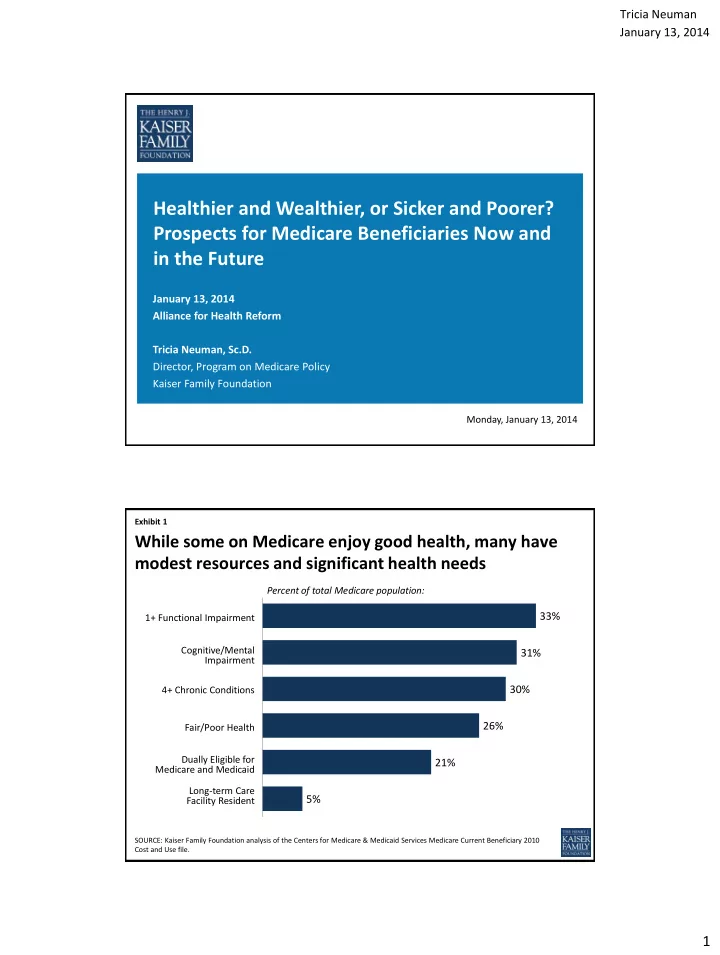

Tricia Neuman January 13, 2014 Healthier and Wealthier, or Sicker and Poorer? Prospects for Medicare Beneficiaries Now and in the Future January 13, 2014 Alliance for Health Reform Tricia Neuman, Sc.D. Director, Program on Medicare Policy Kaiser Family Foundation Monday, January 13, 2014 Exhibit 1 While some on Medicare enjoy good health, many have modest resources and significant health needs Percent of total Medicare population: 33% 1+ Functional Impairment Cognitive/Mental 31% Impairment 30% 4+ Chronic Conditions 26% Fair/Poor Health Dually Eligible for 21% Medicare and Medicaid Long-term Care 5% Facility Resident SOURCE: Kaiser Family Foundation analysis of the Centers for Medicare & Medicaid Services Medicare Current Beneficiary 2010 Cost and Use file. 1
Tricia Neuman January 13, 2014 Exhibit 2 Even with Medicare and supplemental coverage, Medicare households spend far more than others on health expenses Medicare Household Spending Non-Medicare Household Spending Transportation Transportation Health $9,660 $5,087 Care 18% $2,772 Housing 15% Housing 5% $11,673 Health Care $16,976 34% $4,722 32% 14% Food $7,890 15% Food Other $5,189 Other $7,321 15% $15,702 22% 30% Average Household Spending = Average Household Spending = $33,993 $53,000 SOURCE: Kaiser Family Foundation analysis of the Bureau of Labor Statistics Consumer Expenditure Survey Interview and Expense Files, 2012. Exhibit 3 Medicare faces range of challenges Budget and financing • Medicare is 16% of the federal budget and rising as a share of the budget and the economy • Medicare faces long-term financing challenges, with fewer workers to support retirees, and growing number of Medicare beneficiaries Beneficiaries • Beneficiaries incur relatively high out-of-pocket expenses as a share of income and household budgets (no limit on spending, dental, or long-term care) • Medicare’s benefit structure is complex (traditional Medicare); unclear how well beneficiaries navigate private marketplace, but have many choices Other challenges • Improving care management and targeting interventions to beneficiaries with the greatest needs and highest costs • Setting fair payments to plans and providers (e.g. the SGR) 2
Tricia Neuman January 13, 2014 Exhibit 4 Projected Medicare spending has declined since the enactment of the ACA in 2010 Medicare Baseline Spending Average annual growth rate, 2010-2019: • Projected spending before ACA: 6.8 percent (in $ billions) • Projected spending after ACA: 4.8 percent $1,000 $943 Projected Medicare $900 $854 spending before ACA $819 $787 $800 $803 $725 $696 $700 $730 $635 $703 $678 $580 $600 $570 $622 $603 $521 $592 $565 $557 Projected Medicare $500 $526 Spending after ACA $400 2010 2011 2012 2013 2014 2015 2016 2017 2018 2019 NOTE: Estimates do not take into account future changes to the Sustainable Growth Rate formula to prevent reduction in fees. SOURCE: Medicare Baseline Spending before reform from CBO, March 2009 Baseline: MEDICARE; after reform from CBO, May 2013 Baseline: MEDICARE. Exhibit 5 On a per person basis, Medicare spending is projected to grow slower than private insurance Actual (2000-2011) Projected (2012-2021) 6.9% 6.6% 5.0% 4.1% 3.2% 2.9% 2.5% 2.1% Medicare Private health GDP CPI Medicare Private health GDP CPI spending insurance per capita spending insurance per capita per capita spending per capita* spending per capita per capita NOTE: *Assumes no reduction in physician fees under Medicare between 2012 and 2021. SOURCES: Medicare spending per capita from Boards of Trustees and Congressional Budget Office (CBO), Private health insurance spending per capita from the CMS National Health Expenditure data, GDP per capita from CBO and U.S. Census Bureau, historical CPI from the Bureau of Labor Statistics (BLS), and projected CPI from CBO. 3
Tricia Neuman January 13, 2014 Exhibit 6 Several Medicare proposals could directly affect beneficiaries ’ out -of-pocket costs Savings Benefit Improvements Raise Medicare Part B and D premiums Strengthen financed protections for low- for beneficiaries with higher incomes income beneficiaries Introduce home health copayments (for Provide new limit on out-of-pocket all/new enrollees) expenses under Parts A and B Raise Part B deductible (for all/new Expedite closing of Medicare Part D enrollees) “donut hole” Impose premium surcharge for Medigap/retiree coverage; prohibit “first dollar” Medigap coverage Restructure Medicare’s benefit design Raise the age of Medicare eligibility Premium support/ defined contribution 6 4
Recommend
More recommend